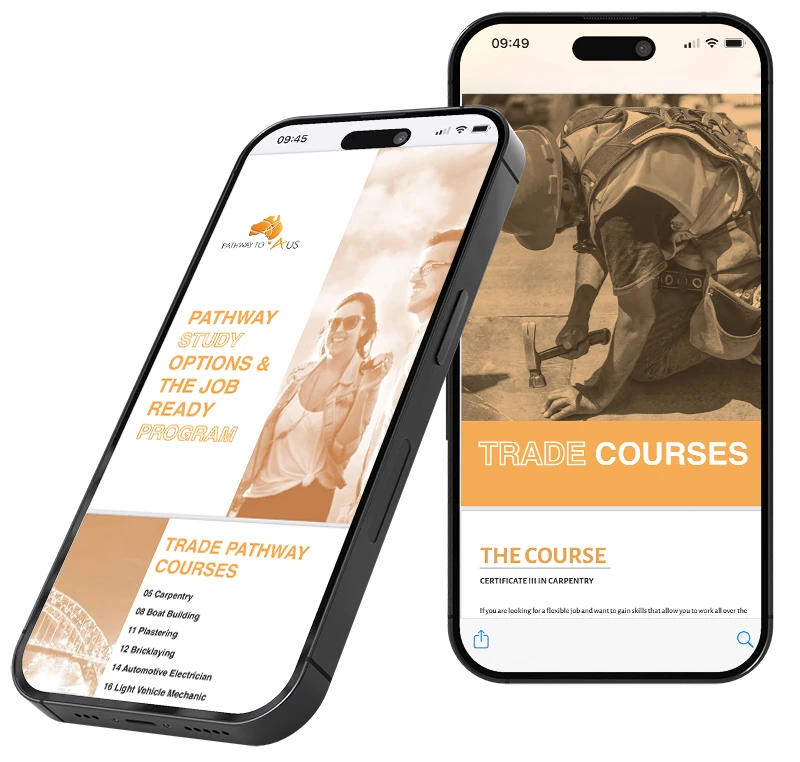Carpentry Course & PR Pathways 2025 Guide
Download our free 2025 guide to discover how a Certificate III in Carpentry can open doors to career opportunities in Australia and lead toward permanent residency.
Get Your Free Guide
Enter your details to download the comprehensive PDF guide instantly.
Carpentry Course Guide Includes
Carpentry is one of the most in demand trades in Australia, offering international students both practical skills and strong career outcomes. This guide is designed to help you understand the Certificate III in Carpentry, covering entry requirements, costs, course structure, and how this program connects with Australia’s migration pathways.
By studying carpentry, you will gain hands on experience through classroom training and workplace placement while building skills that are valued across the construction industry. Graduates often move into full time roles with strong salaries, and carpenters remain on Australia’s Medium and Long Term Strategic Skills List, making this trade a recognised pathway toward permanent residency.
This 2025 guide explains the complete process step by step, from enrolling in a course to securing post study work opportunities and exploring visa options that can lead to long term residency in Australia.
 Available
Available
Nicholas Yock
Study Pathways to PR Specialist
10+ Years of Experience
What you’ll get?
Everything you need to understand the Certificate III in Carpentry and map your pathway to Australia
Course Structure
Entry Requirements
Study Duration & Fees
Vocational Placement
Application Process
Post-Study Pathways

Carpentry Course to PR FAQs
Get clear answers to the key questions international students ask about studying carpentry in Australia and how it can lead to permanent residency.
Is the ebook really free?
What is the Certificate III in Carpentry & do I need it?
Certificate III in Carpentry is a nationally recognised trade qualification in Australia. It gives you the essential carpentry skills and practical experience needed to work in construction. It’s often the required minimum for skilled migration via carpentry pathways.
How long does the course take & how much does it cost?
It typically takes about 2 years full-time for international students. Cost depends on the education provider and location but expect somewhere between AUD 20,000-30,000/year for tuition plus tools, materials, living costs etc.
What visa do I need after studying carpentry to stay in Australia?
After completing the course you’re likely eligible for the Temporary Graduate Visa (Subclass 485), which gives you work rights. During that time you can gain work experience needed for the skills assessment and then apply for a skilled migration visa for permanent residency.
What is the skills assessment, and how do I get a positive one?
A skills assessment verifies that your carpentry skills meet Australian industry standards. For carpenters this is usually done via Trades Recognition Australia (TRA). You’ll need to show your qualification (Certificate III) and relevant industry experience, sometimes work hours, depending on your background.
Is permanent residency guaranteed once I complete the course?
No. The course is the first step, but PR is not guaranteed. You’ll need to meet other criteria: work experience, skills assessment, English proficiency, visa subclass conditions, and sometimes state or regional nomination.
How many points do I need for skilled migration as a carpenter?
The points required vary depending on visa subclass, English level, age, work experience etc. Carpentry is on the Medium and Long Term Strategic Skills List (MLTSSL) which helps, but you’ll need to check current migration rules for the exact points.
Can I work part-time while studying?
Yes, but there are restrictions. Student visa holders can usually work limited hours per week during study periods. Also some of the work you gain must be relevant and counted properly for post-study visa/skills assessment.
Do I need a White Card or other safety certifications?
Yes! For carpentry, since you’ll be working on construction sites, you’ll usually need to complete the general construction induction (often called the White Card) to meet safety requirements.
Where should I study? Which states or regional areas offer better chances for PR?
It depends. Regional areas or states with labour shortages sometimes give nomination or bonus points in migration. Also the cost of living and availability of work placements vary. Research what each state offers (nomination, additional points etc) to find the best fit. Check out this video of the best regional areas to study in Australia.
Success Stories
First-hand stories from people we’ve helped secure visas, overcome challenges, and start a new chapter in Australia.
